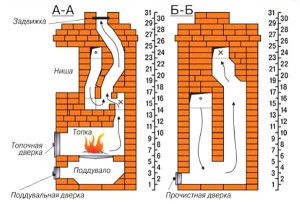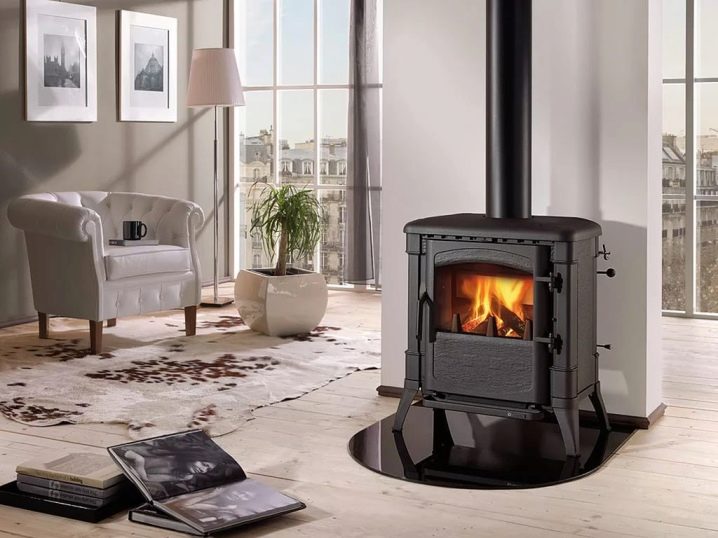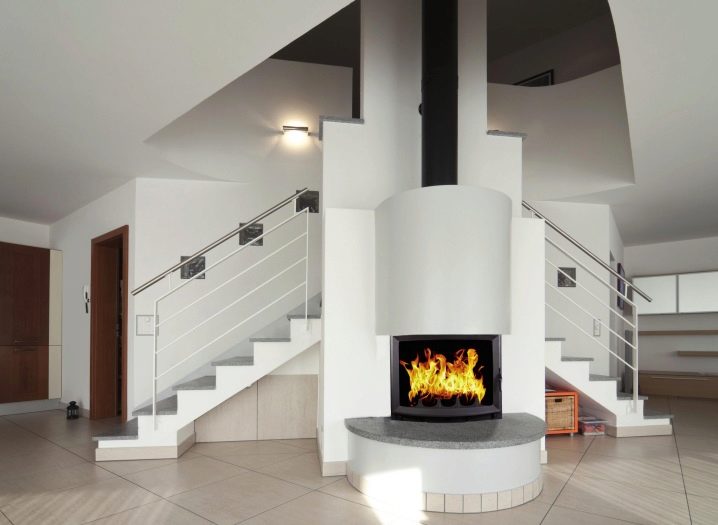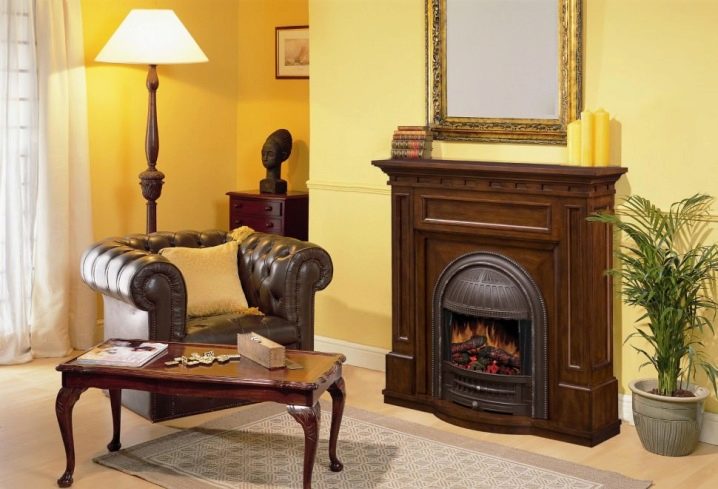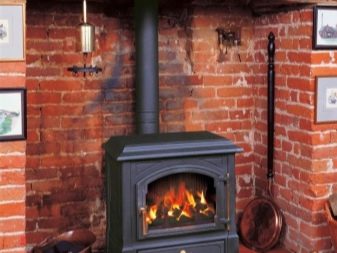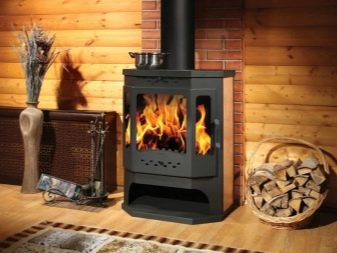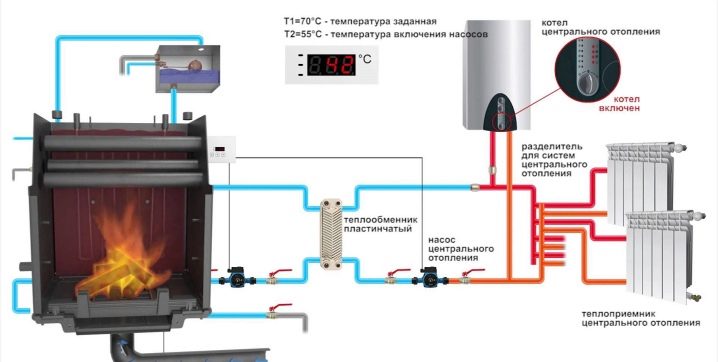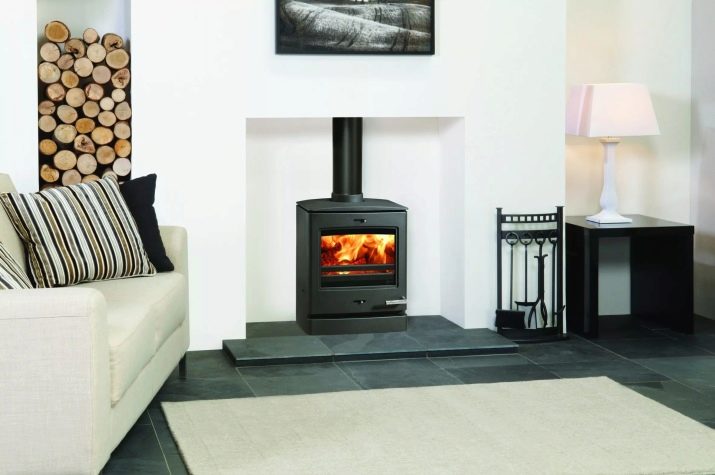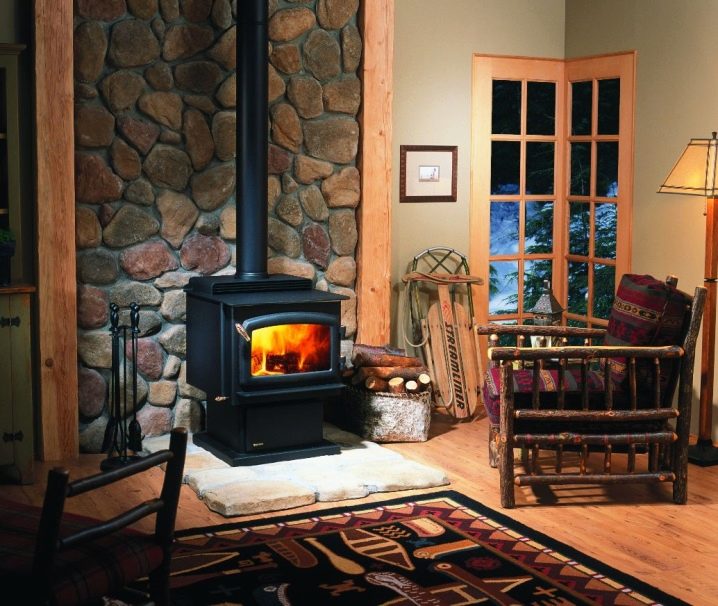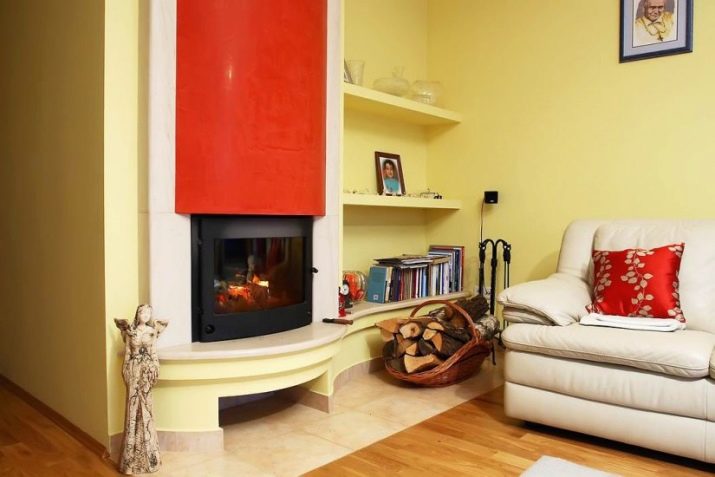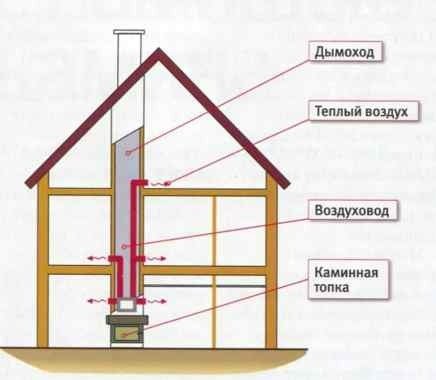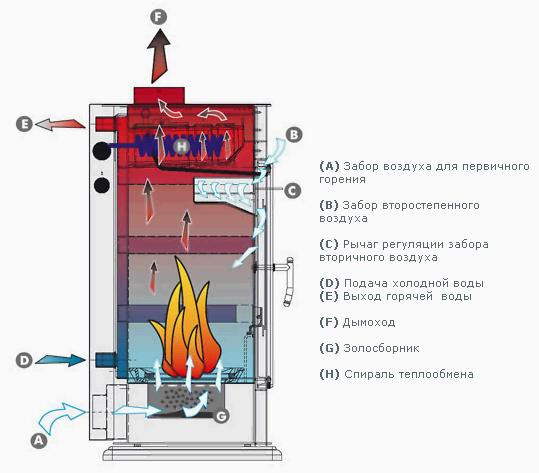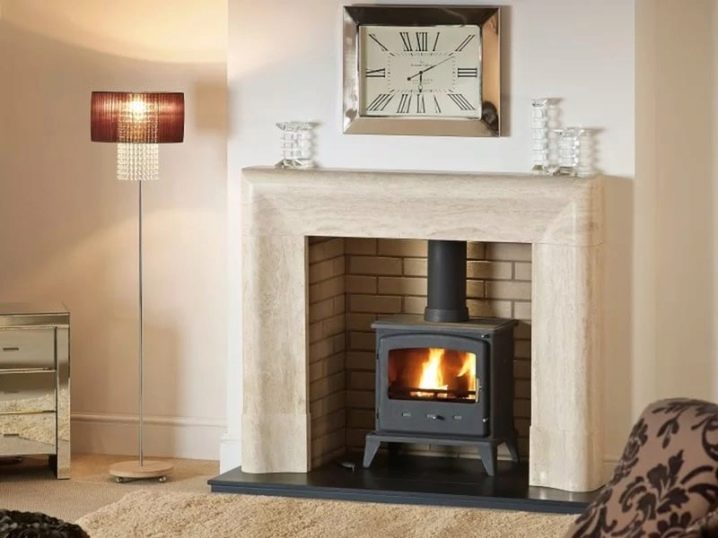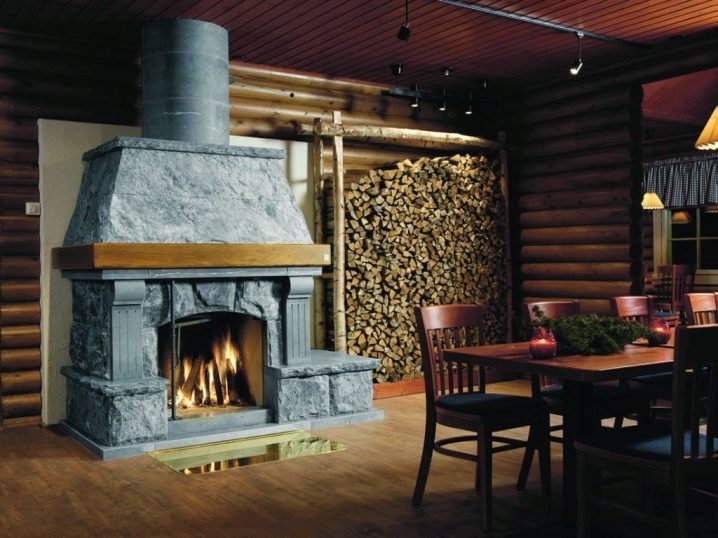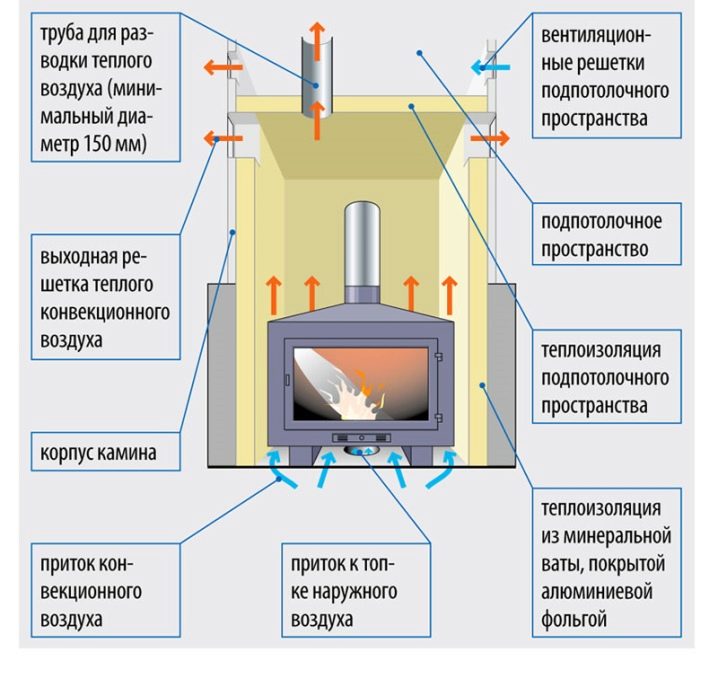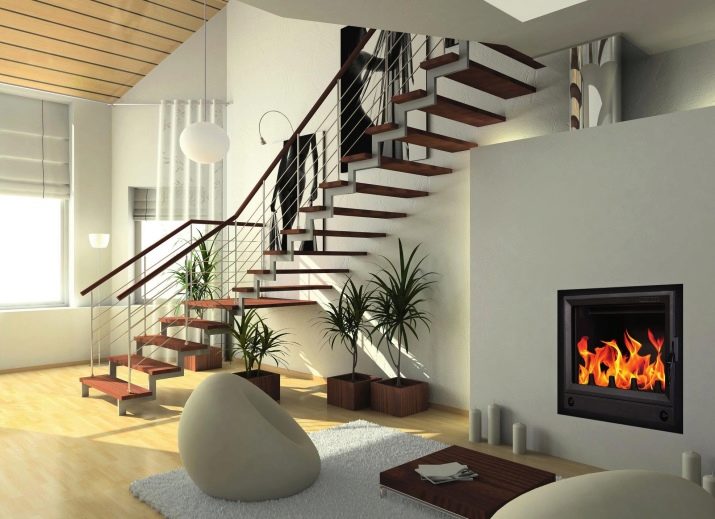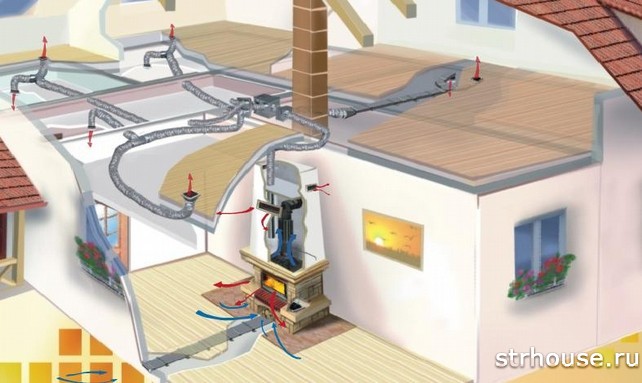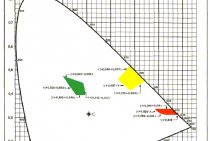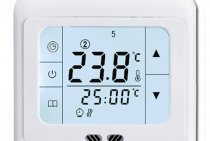Furnace heating requirements
Traditional oven design
A traditional stove is a brick structure that has a firebox, an ash pan and a flue system. The latter played an important role, since the heating of the house was due to the heat of carbon monoxide, which passed through a complex system of channels.
However, for houses with a large area, such a scheme is not effective. Therefore, they prefer to do water heating from the stove with their own hands. To do this, a heat exchanger is installed in the furnace to heat the coolant - water, air or to generate steam. Such a scheme will increase the heating efficiency and significantly increase the heating area in the house.
- It is recommended to place the stove not with a load-bearing wall so that a system of chimney channels can be equipped;
- The material for the manufacture of the floor and walls in the area of \u200b\u200bthe furnace must be non-combustible;
- Mandatory installation of a protective door in the blower and firebox;
- Drawing up a schedule for cleaning the chimney from soot and soot. This procedure should be carried out at least once every 2 months and before each heating season.
How to build a stove with water heating with your own hands? First you need to choose the optimal design that will meet the requirements of a particular house. There are many construction schemes - from the simplest designs to complex ones with sunbeds and ovens.
The height of the chimney of the furnace should not be less than 4 m. Otherwise, due to the high temperature of carbon monoxide, condensate will accumulate on its surface, which will inevitably fall into the combustion chamber.
Advantages and disadvantages
Fireplaces with a heating circuit have the following advantages:
- with an existing heating system, they are easily connected to it;
- can have hot water function;
- use environmentally friendly and safe fuel;
- due to heat removal, they do not allow the furnace to overheat;
- allow you to heat large rooms with a second floor;
- fireproof;
- some models of long-term heating inserts have additional functions, such as hobs for cooking.
From customer reviews, you can also find common shortcomings:
- adjustment of the heat supply is possible only in manual mode, unlike many athematic systems on gas, electricity and solid fuel;
- compared to other systems, this is not the most efficient way of heating with radiators, especially in harsh winters.
How to connect
Connecting a fireplace with a water or air circuit can be done in a selected place, as long as it provides for the chimney to be led through the roof to the street. For efficient operation of the smoke exhaust pipe, it must have a distance from the heating tank to its upper end from 3 to 5 m.
The purchased fireplace has the maximum operating power indicated in its data sheet. The model should be chosen depending on the total area of the building:
- 60-200 sq. m. - up to 25 kW;
- 200-300 sq. m. - 25-35 kW;
- 300-600 sq. m. - 35-60 kW;
- 600-1200 sq. m. - 60-100 kW.
The connection diagram for a fireplace with a water circuit contains the distribution of heating pipes by room, indicating the location of thermometers, pressure gauges, radiators, a circulation pump, safety, air and drain valves.
The procedure for connecting the system consists of the following steps:
- Leveling the floor at the location of the fireplace and covering it with a protective layer that protects against high temperatures.
- Installation of the furnace, its regulation by level.
- Installation of a heating pipe system with a circulation pump.
- Connection to the heat exchanger circuit.
- Pumping water into the circuit, checking the operation of the circulation pump and the tightness of all components.
- Installation and connection to the smoke channel of the chimney firebox and its sealing.
- Trial kindling of the fireplace.
When connecting a fireplace with an air duct for heating the whole house, the first steps are identical: leveling and protecting the floor, leveling the device. Air heating systems do not need a pump, hot air circulates through pipes by gravity. For an efficient flow of heated air, it is necessary that the air ducts be no more than 3 m in length, and the entire system should have a minimum number of angular turns.
Refractory aluminum pipes are taken as air ducts in the rooms. This material is able to withstand temperatures up to 250°C. The air ducts themselves have thin walls, light weight and are easy to install anywhere. It is best to mount them to the ceiling with metal hooks or a metal profile frame. For a more aesthetic appearance, the heating system is often hidden under decorative boxes. After installing aluminum pipes, it is necessary to seal them and connect ventilation.
8 photos
Some features of self-designing a fireplace
The project of the house must necessarily include sections devoted to the device of the fireplace and its individual elements.
Above the firebox of each fireplace is its own chimney, the cross-sectional area of the chimney channel of which should be 1/10 of the area of the firebox. The distance from the junction of the chimney to the combustion channel must be at least 5 meters.
The chimney channel should be equipped with a special damper that will separate the firebox from the chimney, and an opening designed to remove soot accumulating during operation. The design of the slide gate valve can be retractable or fixed (with the help of piano hinges).
Average fireplaces can weigh around 500 kilograms or more. Therefore, under the fireplace, it is necessary to provide a sufficiently strong and reliable foundation.
If a fireplace is to be installed in an already built house, then it may be necessary to carry out additional work to strengthen the supporting structures.
Fireplaces with air heating
Air heating of rooms and premises with a fireplace provides for heating the air passing between the body of the furnace and its outer surface.
Scheme of a fireplace with air heating. Click to enlarge.
The distribution of heated air through the rooms of the house is carried out using pipeline channels installed in the walls or in the ceilings.
Aluminum or steel pipes are perfect for arranging air channels.
In simpler schemes, the gravitational method is used to supply air, based on a different value of the density of cold and warm air.
Fireplace air heating of this type does not depend on electrical energy, but it can be used to heat just a few rooms.
Fireplace air heating of a house with a large number of rooms and a pipeline length of more than 3 meters should be carried out according to a forced circulation scheme.
Such a scheme should include a pump that supplies air under the furnace body or above itself.
Forced air circulation can provide high-quality heating of a fairly large country house.
When choosing and installing such a scheme, it should be remembered that air exchange proceeds in a closed cycle.
It is more rational to build a fireplace with air heating during the construction of a house, since otherwise you will have to face tedious and very costly work - punching holes intended for laying air ducts.
Fireplaces with a water cloak
The firebox of fireplaces with a water cloak has one significant structural difference - the body of the firebox consists of two layers, between which heated water circulates.
A fireplace in your room is not only an interior element, but also a source of heat.
The heated water is supplied to the radiators of the heating system using special pipelines.
The device of a special heat exchanger (coil) in the upper part of the fireplace will provide an opportunity not only to heat the premises, but also to heat water for domestic purposes, the circulation of which will be carried out by special pumps.
The structure of the fireplace with a water mantle. Click to enlarge.
Manual regulation of the operation of fireplaces is possible by increasing or decreasing the flow of air into the fireplace furnace. Automatic regulation is carried out due to the operation of thermostats, which are equipped with pumps.
Thermostats provide automatic switching on of the pumps after heating the water to the required temperature.
Principle of operation
Factory models of heating boilers for such fireplaces have a heat exchanger around the body in the form of a spiral or a radiator made of thin pipes through which water or air circulates. When heated, they flow through the heating pipes to the batteries in other rooms.
A fireplace with a wood-fired water circuit has a low efficiency, not exceeding 60%. In addition, simple models for the effective supply of heat to the house require constant firewood. Pellet fireplaces are spared these problems. They use pellets as fuel, which have a higher specific heat of combustion than firewood. The pellet is automatically loaded from the rear side of the firebox. It is possible to regulate the intensity of supply and, consequently, the power of the fireplace using an electric control panel.
Ducted fireplaces can be up to 80% efficient. Sophisticated models can be designed with the function of heating in the firebox and wall. In this way, maximum heating of the circulating air is achieved. Unlike water circuits, air systems require fans, and this requires additional wiring and more power consumption. But on the other hand, pipes for them are less demanding on strength, most often they are made of thin and cheap aluminum.
For safety, most fireplaces with air and water circuits are equipped with a safety glass door. Heat enters the room through this glass due to infrared radiation. This eliminates the possibility of sparks entering the room, and the owners can enjoy the sight of a bright flame. For the cleanliness of the glass damper, a soot protection is provided.
Types of fireplaces for home heating
First of all, fireplaces are distinguished by the type of combustion chamber device:
- Open fireplace. This is a decorative version of the heating structure - a fireplace without walls looks beautiful, but its efficiency is low, it heats only the room in which it is located, and then only partially if the area of \u200b\u200bthe room is large.
- Semi-open fireplace. It is attached to the wall or deepened into it, one of the walls is missing, which allows you to observe the combustion process. The heat transfer potential of such a design is already higher; it can be used as a full-fledged additional source of heating for the house.
- Closed fireplace. In the vast majority of cases, this is a fireplace built into the wall, separated from the room by a metal shutter or heat-resistant glass. This is the safest in terms of fire hazard and the most efficient in terms of thermal potential fireplace option. Such a fireplace stove for home heating is quite suitable even as the main source.
In order to use a fireplace as a heating source for a home, it will need a distribution system that will distribute the heat throughout the rooms. On this basis, fireplaces are divided into two groups: with water heating and with air.
Fireplace with air heating
These are closed-type fireplaces, in which there is no direct contact with the room air. The design of the fireplace includes air ducts that distribute heated air throughout the house.Both natural and forced distribution of hot air throughout the premises can be used to increase efficiency. Such fireplaces are both floor and built-in.
Natural convection circulation of flows is effective for heating only one room. For heating several rooms, forced hot air is required. It is carried out using built-in fans powered by electricity. Air ducts lead to each room, which is supposed to be heated with a fireplace.
Fireplace with water heating
Fireplace heating of a private house can be arranged using a fireplace with a water circuit.
Such a fireplace is connected to the radiator water heating system of the house. As an additional functionality, it has a hob. There are varieties such as fireplace stoves with a water circuit made of cast iron and other metals.
A fireplace with a heat exchanger can be used as a spare, backup method of heating a country house, for example, when using a gas boiler as the main source. Such a fireplace can be used without heating water for heating, which may be relevant in summer.
Fireplace as a heating device
So, having chosen a fireplace, it was necessary to find out whether it would be suitable as a solution to the problem. Fireplace as a heating device? Why not.
Although recently a fireplace from a completely utilitarian heating device, which it has traditionally been, for example, in England and European countries (Russians preferred stoves), has become, rather, a designer “thing” in the interior, plus a demonstration of the wealth of the owner. Most often, a fireplace is not a cheap pleasure, and in some cases it can become a true luxury item, the cost of which is quite comparable to the price of a whole summer house in a prestigious area.
Fireplace as a luxury item
A modern fireplace can easily perform various functions: it can only be an excellent interior decoration (for example, bio-fireplaces) or, in addition to a decorative role, also serve as a source of heat. The main thing is to choose the right model and install it according to your needs.
Types of fireplaces
Since this article is about a fireplace as a heating device, we will not waste time considering purely interior options and decorative ways to design the outside.
Let's pay attention to the furnace part
traditional English fireplace
An English fireplace is a fireplace with an open rectangular firebox. Rumford's fireplace is an improved variation of the classic English fireplace, it has a trapezoidal firebox. In terms of heating, this is the least efficient device. Its efficiency, as a rule, is very low: from 5 to 20%. An open firebox does not allow you to regulate the intensity of combustion, the hearth burns a lot of fuel, giving out intense heat during operation, and quickly cools down when active combustion stops.
Classic open fireplace English type with a rectangular firebox
modern indoor fireplace
Today, consumers are more likely to choose closed-type fireplaces - having a tight-fitting door with fire-resistant glass. The door allows you to use fuel more economically. In addition, "advanced" models have built-in valves that regulate the intensity of combustion. Manufacturers of some furnaces claim that the efficiency of their products reaches 85%.
Of course, they are cunning: the efficiency for devices operating on such an unstable fuel as firewood is a very subjective concept. The efficiency of a fireplace or stove depends not only on the device of the furnace itself, but also on the type of firewood (hot birch, oak or larch, or so-so firewood - alder or poplar), on their humidity and other things.
Closed-type fireplaces: many different ones, but are they all good?
In the modern version, the fireplace is a metal box - a fireplace insert or a factory-made fireplace cassette with a tight door equipped with glass and adjustment knobs (various valves, blower, dampers). There is also a branch pipe for accession to the chimney. The furnace chamber can be cast iron or steel, lined with fireclay plates.
Depending on the model, the furnace can be equipped with a smoke collector of various designs, a second afterburner chamber, a thermal casing, convective channels, a circuit for installing a water heating system and other necessary and useful devices that increase the efficiency of the device and the comfort of its use.
Fireplace Invicta Gaya Ardoise. Photo from invicta.su
In addition to fireplace inserts and fireplace cassettes, there are also fireplace stoves, kaminetti (self-sufficient fireplace inserts that do not need additional decorative framing), just stoves and just fireplaces. That is, in addition to the traditional stove product, built of bricks by a master stove-maker directly at the facility, good ready-made options are offered for sale, made in a production environment, using modern engineering solutions.
In more detail about the device of fireplace inserts and the agony of choosing the very best firebox, fireplace or stove, you need to write separately. Here I want to talk about the option that was chosen for this particular project.
Advantages, disadvantages
The positive qualities of the units include:
- the principle of operation of a simple fireplace model: the release of thermal energy of the furnace occurs during the process of fuel combustion;
- chimney ducts are designed to remove carbon monoxide. If you additionally provide channels through which air will move convectively, the temperature marks will become higher;
- there is no localization of heating zones near the fireplace;
- simplicity, lightness of the air circulation system of the heat carrier;
- high level of security. Compared to a water circuit, even the smallest hole in a pipeline can cause a burst. Hot water can cause burns, severely harm a person;
- lack of a thermal carrier;
- lightness, ease of turning on, turning off heating;
- in comparison with the water circuit, it is significantly cheaper;
- no temperature fluctuations in localization zones.
Negative sides:
- the cost of organizing the system. Permanent bookmark of fuel;
- fuel cost.
